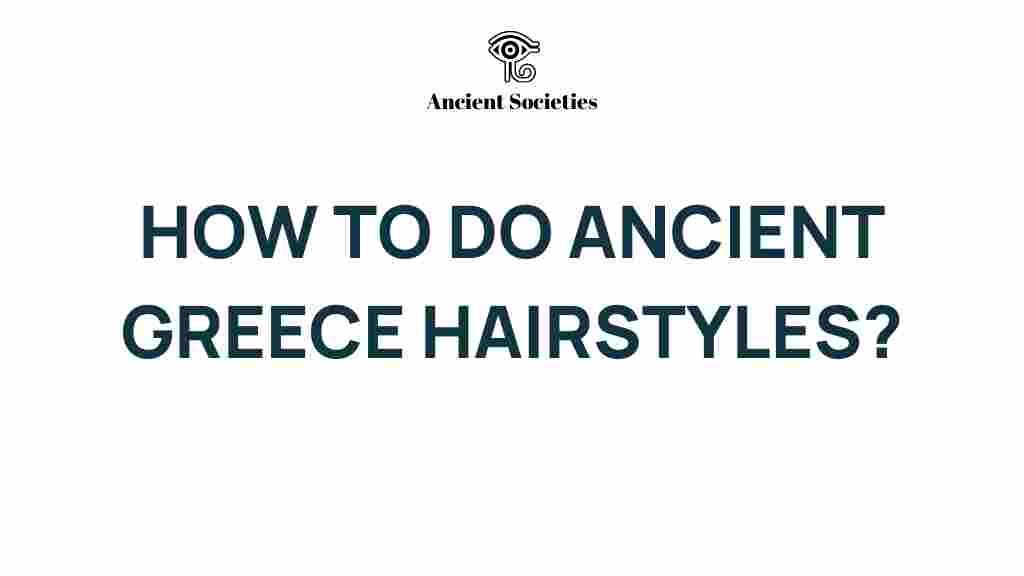Unveiling the Secrets of Ancient Greece: Hairstyles, Beauty, and Culture
Ancient Greece is renowned for its contributions to art, philosophy, and democracy, but one of its lesser-known yet fascinating aspects is its grooming and hairstyles. The hairstyles of ancient Greece were not merely a matter of personal preference; they were deeply intertwined with the culture, history, and traditions of the time. This article will explore the various hairstyles of ancient Greece, their significance, and how they reflect the beauty and fashion standards of that era.
The Historical Context of Ancient Greek Hairstyles
In ancient Greece, hairstyles varied significantly based on several factors, including gender, social status, and the period in question. The ancient Greeks believed that beauty was a reflection of one’s character and virtues. As such, grooming and hairstyling were considered important aspects of maintaining one’s public image.
From the Archaic period (circa 800-480 BCE) to the Hellenistic period (323-30 BCE), hairstyles evolved dramatically. Initial styles were influenced by practicality, while later trends embraced elaborate designs that showcased wealth and artistry. The significance of hair in ancient Greek society cannot be understated; it was often seen as a symbol of identity, status, and even divine favor.
Common Hairstyles in Ancient Greece
Ancient Greek hairstyles were diverse and often quite intricate. Here are some of the most notable styles:
- The Chignon: This style involved gathering hair into a bun at the nape of the neck. It was a popular choice among women, especially for those of higher social status.
- The Braid: Braids were common and could be worn in various forms. Women often adorned their braids with ribbons or gold threads, while men might braid their hair simply.
- Loose Waves: Some women, particularly in the Hellenistic period, opted for loose, flowing curls that framed their faces, creating an ethereal look.
- The Warrior’s Cut: Men, especially soldiers, often wore shorter hairstyles, sometimes shaved on the sides, to convey strength and readiness for battle.
- The Laurel Crown: Both men and women wore laurel crowns, especially during festivals, symbolizing victory and honor.
Tools and Techniques for Grooming
Grooming in ancient Greece was a meticulous process, often involving various tools and techniques. The Greeks utilized:
- Pins and Combs: Made of bone, wood, or metal, these tools were essential for arranging hair into elaborate styles.
- Fragrances and Oils: Hair oils and perfumes were crafted from natural ingredients like olive oil, herbs, and flowers to keep hair healthy and fragrant.
- Hot Irons: For those desiring curls, heated tools were used to create waves and curls in the hair, similar to modern curling irons.
Step-by-Step Guide to Creating Ancient Greek Hairstyles
If you’re inspired by the timeless beauty of ancient Greek hairstyles, here’s a simple guide to creating a classic Greek chignon:
- Preparation: Start with clean, dry hair. Apply a light oil or hair serum to give your hair shine and manageability.
- Gathering the Hair: Use a comb to smooth your hair back and gather it into a low ponytail at the nape of your neck.
- Forming the Chignon: Twist the ponytail and wrap it around the base to form a bun. Secure it with hairpins.
- Finishing Touches: Use a decorative hairpin or ribbon to adorn the bun. Optionally, leave out some strands to frame your face.
Common Challenges and Troubleshooting
Creating ancient Greek hairstyles can be challenging. Here are some troubleshooting tips to help you achieve the perfect look:
- Frizz: If your hair tends to frizz, use a smoothing serum before styling to keep it sleek.
- Securing the Style: If your chignon doesn’t hold, use more bobby pins or an elastic band to secure it tightly.
- Volume: For added volume, tease the hair at the crown before gathering it into a ponytail.
The Cultural Significance of Hairstyles
Hairstyles in ancient Greece were not just about aesthetics; they held deep cultural significance. For instance:
- Social Status: The complexity of one’s hairstyle often indicated social standing. Elaborate styles were reserved for the elite, while simpler styles were common among the lower classes.
- Religious Practices: Certain hairstyles were worn during religious ceremonies, showcasing devotion and piety.
- Gender Norms: Men and women had distinct styles that reflected their roles in society. Men’s shorter styles communicated strength, while women’s longer hairstyles represented femininity and grace.
Modern Interpretations of Ancient Greek Hairstyles
Today, the allure of ancient Greek hairstyles continues to inspire fashion and beauty trends. Many modern hairstylists draw inspiration from these timeless styles, creating contemporary versions for special occasions such as weddings and proms. Here are some popular modern interpretations:
- Bohemian Buns: Loose, relaxed buns that echo the chignon are favored in modern weddings.
- Beachy Waves: Inspired by the flowing locks of ancient goddesses, beachy waves are popular for casual and formal events.
- Braided Crowns: This style mimics the laurel crowns of ancient Greece and adds a touch of elegance to any hairstyle.
Conclusion: Embracing the Beauty of Ancient Greek Hairstyles
Ancient Greece has left a lasting legacy in various fields, and its hairstyles are a testament to the culture’s appreciation for beauty, art, and tradition. By understanding the significance of these hairstyles, we can appreciate how they reflect the values and beliefs of the time.
Whether you’re looking to adopt an ancient Greek hairstyle for a special occasion or simply wish to explore the rich history of beauty and fashion, the allure of ancient Greece continues to inspire. As you experiment with these styles, remember that they are more than just hair—each strand represents a thread in the tapestry of history, culture, and artistry.
For more insights into ancient fashion trends, check out this comprehensive guide.
To dive deeper into the world of ancient beauty practices, visit this resource page.
This article is in the category Culture and created by AncientSocieties Team
